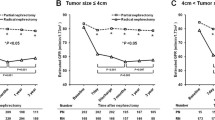Abstract
Background
We investigated factors affecting mild (MRFD) and severe renal functional deterioration (SRFD) after radical nephrectomy with a special focus on the histopathology of nephrectomized non-neoplastic renal parenchyma.
Methods
MRFD was defined as a postoperative decline of percent estimated glomerular filtration rate (eGFR) lower than the value of the mean minus standard deviation (SD). SRFD was defined as a rate greater than the value of the mean plus SD. The histopathological factors of global glomerulosclerosis (GS) and arteriosclerosis in non-neoplastic renal parenchyma and multiple clinical factors were analyzed to determine whether they affected postoperative renal functional deterioration in 100 renal cell carcinoma cases. The prognoses, including non-cancer mortality, were collected from long-term follow-up data.
Results
A higher preoperative eGFR and a higher global GS extent in non-neoplastic renal parenchyma were independently associated with MRFD and SRFD, respectively. The cardiovascular disease-specific survival rates of the SRFD group and the group with global GS extent >14 % were significantly worse than those of their counterparts.
Conclusions
This is the first report to identify global GS extent in nephrectomized non-neoplastic renal parenchyma as a factor affecting the development of life-threatening post-nephrectomy renal functional deterioration. Moreover, we are the first to advocate the importance of the characterization of favorable post-nephrectomy renal functional deterioration. The identification of MRFD and SRFD by histopathological evaluation of nephrectomized non-neoplastic renal parenchyma will contribute to personalized postoperative follow-up. It may improve follow-up of individual patients with SRFD by permitting collaboration with other clinical departments such as cardiology.


Similar content being viewed by others
References
Pahernik S, Ziegler S, Roos F et al (2007) Small renal tumors: correlation of clinical and pathological features with tumor size. J Urol 178:414–417
Remzi M, Ozsoy M, Klingler HC et al (2006) Are small renal tumors harmless? Analysis of histopathological features according to tumors 4 cm or less in diameter. J Urol 176:896–899
Huang WC, Levey AS, Serio AM et al (2006) Chronic kidney disease after nephrectomy in patients with renal cortical tumours: a retrospective cohort study. Lancet Oncol 7:735–740
Campbell SC, Novick AC, Belldegrun A, Practice Guidelines Committee of the American Urological Association et al (2009) Guideline for management of the clinical T1 renal mass. J Urol 182:1271–1279
Brenner BM (1985) Nephron adaptation to renal injury or ablation. Am J Physiol 249:F324–F337
Rennke HG, Klein PS (1989) Pathogenesis and significance of non primary focal and segmental glomerulosclerosis. Am J Kidney Dis 13:443–456
Matsuo S, Imai E, Horio M, Collaborators developing the Japanese equation for estimated GFR et al (2009) Revised equations for estimated GFR from serum creatinine in Japan. Am J Kidney Dis 53:982–992
Bijol V, Mendez GP, Hurwitz S et al (2006) Evaluation of the nonneoplastic pathology in tumor nephrectomy specimens: predicting the risk of progressive renal failure. Am J Surg Pathol 30:575–584
Go AS, Chertow GM, Fan D et al (2004) Chronic kidney disease and the risks of death, cardiovascular events, and hospitalization. N Engl J Med 351:1296–1305
Henriksen KJ, Meehan SM, Chang A (2007) Non-neoplastic renal diseases are often unrecognized in adult tumor nephrectomy specimens: a review of 246 cases. Am J Surg Pathol 31:1703–1708
Cancer Protocols and Checklists: College of American Pathologists. Available at http://www.cap.org/apps/docs/committees/cancer/cancer_protocols/2009/Kidney_09protocol.pdf. Accessed 7 January 2010
Bonsib SM, Pei Y (2010) The non-neoplastic kidney in tumor nephrectomy specimens: what can it show and what is important? Adv Anat Pathol 17:235–250
Gautam G, Lifshitz D, Shikanov S et al (2010) Histopathological predictors of renal function decrease after laparoscopic radical nephrectomy. J Urol 184:1872–1876
Roos FC, Brenner W, Jäger W et al (2011) Perioperative morbidity and renal function in young and elderly patients undergoing elective nephron-sparing surgery or radical nephrectomy for renal tumours larger than 4 cm. BJU Int 107:554–561
Lane BR, Fergany AF, Weight CJ et al (2010) Renal functional outcomes after partial nephrectomy with extended ischemic intervals are better than after radical nephrectomy. J Urol 184:1286–1290
Ohno Y, Nakashima J, Ohori M et al (2011) Impact of tumor size on renal function and prediction of renal insufficiency after radical nephrectomy in patients with renal cell carcinoma. J Urol 186:1242–1246
Lane BR, Campbell SC, Demirjian S et al (2013) Surgically induced chronic kidney disease may be associated with a lower risk of progression and mortality than medical chronic kidney disease. J Urol 189:1649–1655
Demirjian S, Lane BR, Derweesh IH et al (2014) Chronic kidney disease due to surgical removal of nephrons: relative rates of progression and survival. J Urol 192:1057–1062
Lane BR, Demirjian S, Derweesh IH et al (2015) Survival and functional stability in chronic kidney disease due to surgical removal of nephrons: importance of the new baseline glomerular filtration rate. Eur Urol. doi:10.1016/j.eururo.2015.04.043
Kates M, Badalato GM, Pitman M et al (2011) Increased risk of overall and cardiovascular mortality after radical nephrectomy for renal cell carcinoma 2 cm or less. J Urol 186:1247–1253
Huang WC, Elkin EB, Levey AS et al (2009) Partial nephrectomy versus radical nephrectomy in patients with small renal tumors—is there a difference in mortality and cardiovascular outcomes? J Urol 181:55–61
Weight CJ, Larson BT, Gao T et al (2010) Elective partial nephrectomy in patients with clinical T1b renal tumors is associated with improved overall survival. Urology 76:631–637
Levey AS, de Jong PE, Coresh J et al (2011) The definition, classification, and prognosis of chronic kidney disease: a KDIGO Controversies Conference report. Kidney Int 80:17–28
Author information
Authors and Affiliations
Corresponding author
Ethics declarations
Conflict of Interest
The authors declare that they have no conflict of interest.
About this article
Cite this article
Sejima, T., Yumioka, T., Yamaguchi, N. et al. Characterization of mild and severe post-radical nephrectomy renal functional deterioration utilizing histopathological evaluation of non-neoplastic nephrectomized renal parenchyma. Int J Clin Oncol 21, 588–594 (2016). https://doi.org/10.1007/s10147-015-0909-1
Received:
Accepted:
Published:
Issue Date:
DOI: https://doi.org/10.1007/s10147-015-0909-1




